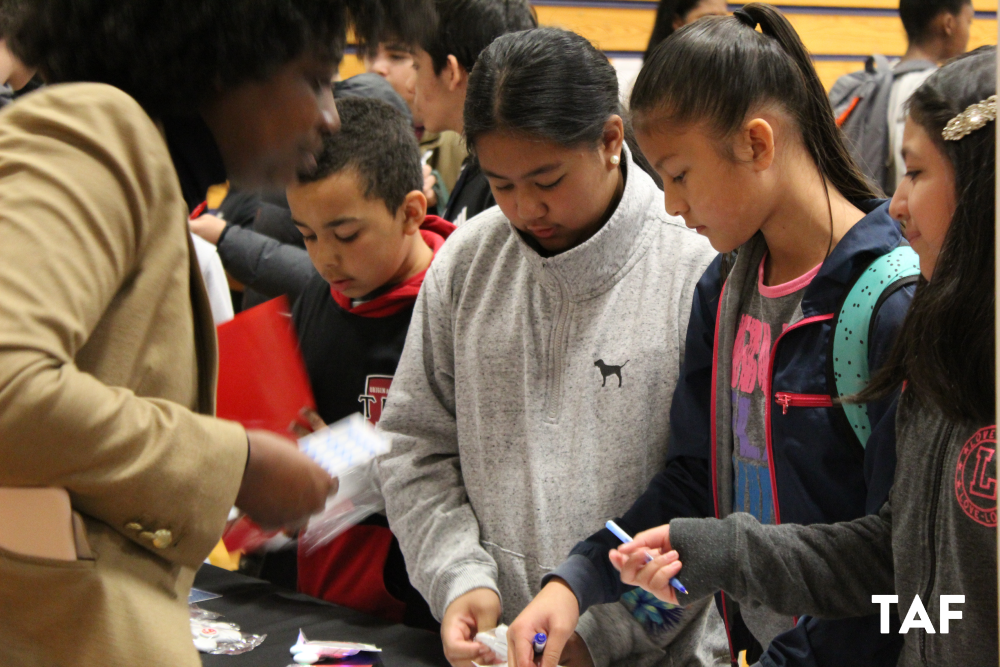TAF Prepares Students for the 21st Century

Technology Access Foundation (TAF) is a success story and on September 13 four members of TAF’s staff told RARE how they did it. All they had to do is improve public education for students of color.
It’s a simple mission but it’s also a tall order. There is no “canned” way to do it, they said. One size does not fit all, and the group’s varied programs reflect that. TAF staff members shared the story of how it lifts each student to his or her potential and meets its mission at RARE’s open discussion session.
Krishna Richardson-Daniels, Dr. Heather Lechner, Maribel Gonzales, and David Goldenkrantz participated in the discussion representing TAF. Their backgrounds are as diverse as the students they serve with experience in public health, education, and community partnerships.
TAF has been improving education for students of color for 25 years – first through the TAF Academy (now TAF@Saghalie in Federal Way), with teacher training, and through its administration of the Martinez Fellowship (as in retired Seattle Mariner Edgar Martinez). The group also partners with public schools through project-based STEM learning which connects the students to their own world. But the words TAF staff used most often during their presentation to RARE weren’t technical at all.
Community. Authenticity. Relationships. TAF builds a community of students, encourages those students to bring their authentic selves to the classroom, and fosters working relationships with entities that can help their mission, such as school districts, community partners, and the tech industry.
Every method that TAF uses to improve outcomes for its student participants is built on a foundation of racial equity. Programs celebrate students’ differences, builds relationships among the students, and uses a multidisciplinary approach to build “communities of high expectations” for the students while keeping the program student centered. Students are encouraged to advocate for themselves. Each of these aspects help students prepare for college or for work in technical fields.
For these educators, it’s personal.
“I wanted to be the person I needed when I was in school,” Gonzales said about her role with students. A Chicana, she is a first-generation college graduate.
TAF was founded by Trish Millines Dziko, a veteran of the technology world, who noticed that she had few co-workers of color. She and co-founder Jill Hull opened in the Columbia City neighborhood of Seattle to serve Black and Brown students. TAF programs serve 2,400 students in the metropolitan Seattle area. The group has a goal to be in sixty schools by 2035.
Goldenkrantz said that grading systems in schools are not equitable and that the traditional education system values testing over student outcomes. TAF’s goal is to bring about a mind shift on racism and to create a space in which students of color can learn without dealing with the inequities that so often happen to students of color in traditional classrooms.
Although test scores are not the goal, TAF graduates are successful in that realm, too. One hundred percent of TAF students are ready for college without remediation, and the students and are in love with learning. Test scores can’t measure that human element, he insisted.
There are obstacles. White teachers aren’t always culturally competent, so improving teacher performance with students of color is an on-going process. TAF has a teacher institute that uses a combination of coaches, professional development, leadership collaboration, and a network of educators to help transform public schools into spaces that provide students of color with educational equity. It includes teachers from around the state.
TAF conducts a “Network for Edwork” to increase the numbers of teachers of color, address systems of inequity, and to dismantle institutional racism, they said.
The program has specifically chosen not to open a charter school so that they would not have to fund overhead. TAF@Saghalie is co-managed with Federal Way public schools and another project is housed in Seattle’s Washington Middle School, where 70 percent of the participants are students of color.
Don’t think that students are spending all their time in purely technical pursuits, such as coding or building robots. The TAF team showed photos of student projects. They included a self-portrait, a human rights museum, and one display on how the 2014 Oso Landslide occurred.
The TAF team concluded its presentation by exploring how TAF can join its academic mission with RARE’s mission to improve racial equity in schools.
